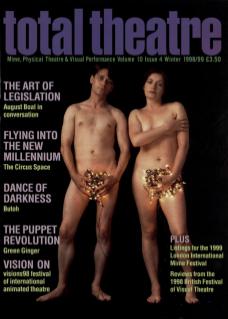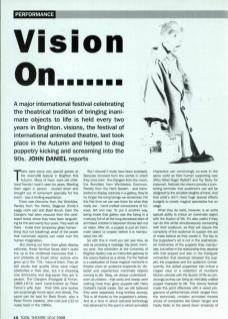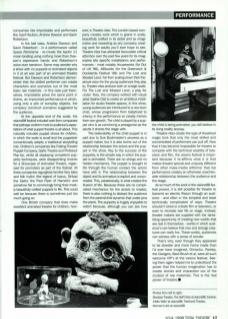There were some very special guests at the visions98 festival in Brighton this Autumn. Many of them were old childhood friends I hadn't seen for years. Meeting them again in person – dusted down and brought out of retirement specially for the event – was a thrilling experience.
There was Orinocho from the Wombles, Parsley from The Herbs, Bagpuss (Emily's saggy cloth cat) and Basil Brush. Even the Clangers had been rescued from the cardboard boxes where they have been languishing for the last 24 years. They were all there – inside their temporary glass homes living (but not breathing) proof of the power that inanimate objects can wield over the human imagination.
But staring out from their glass display cabinets, these familiar faces didn't quite live up to the childhood memories that I – and probably all those other visitors who grew up in the 70s – have of them. They all still exude star quality (they were major celebrities in their day), but it is shocking how diminutive and dog-eared they are in person. The Clangers (Postgate & Firmin, 1969-1974) were hand-knitted by Peter Firmin's wife Joan – their little pink bodies are surprisingly home-spun and dowdy. The same can be said for Basil Brush, also a Peter Firmin creation, who cost just £12 to make back in the 1960s.
But I shouldn't really have been surprised. Because removed from the worlds in which they once lived – the Clangers from the moon, the Wombles from Wimbledon Common, Parsley from the Herb Garden – and transported to display cabinets in a gallery, they're no longer the living beings we remember. For the first time we can see them for what they really are – hand-crafted concoctions of fur, wool, felt and clay. To put it another way, being inside that gallery was like being in a mortuary full of all the long-deceased stars of animated children's television shows laid-out on slabs. After all, a puppet is just an inanimate object (a corpse) before it is manipulated into life.
So with this in mind you can see how, as well as providing a nostalgic trip down memory lane, this exhibition at the University of Brighton Gallery was an instructive gateway to the visions festival as a whole. For the festival is a celebration of those magical moments in theatre when an audience suspends its' disbelief and experiences inanimate objects coming to life. Okay, we always understood – even as children – that Sooty and Sweep were nothing more than glove puppets with Harry Corbett's hands inside. But we still believed they were separately living entities anyway. This is all thanks to the puppeteer's artistry. And at a time in which celluloid technology has advanced to the point in which animated characters can convincingly co-exist in the same world as their human supporting cast (Who Killed Roger Rabbit? and Toy Story, for instance), festivals like visions provide a comforting reminder that audiences can still be delighted by the simplest sleights of hand. And that artists don't need huge special effects budgets to create magical spectacles live on stage.
What they do need, however, is an extra special ability to imbue an inanimate object with the illusion of life. It's also useful if they can do this whilst simultaneously connecting with their audience, as they will require the complicity of the audience to sustain the act of make-believe as they create it. The key to the puppeteer's art is not in the sophisticated mechanics of the puppets they manipulate, but rather in the relationship they develop with that puppet and also in the triangular connection that develops between the puppet, the puppeteer and the audience. Consequently, the skilled puppeteer can imbue a copper vase or a collection of mundane kitchen utensils with the illusion of life as convincingly as they can bring an intricately crafted puppet character to life. The visions festival made this point effectively with a varied programme of performances which ranged from the technically complex animated theatre shows of companies like Green Ginger and Faulty Optic to the pared down simplicity of companies like Improbable and performers like Jozef Houben, Andrew Dawson and Gavin Robertson.
In the last case, Andrew Dawson and Gavin Robertson – in a performance called Space Panorama – re-create the Apollo 11 moon landing using nothing more than Dawson's expressive hands and Robertson's voice-over narration. Some may wonder why a show with no puppets or animated objects in it at all was part of an animated theatre festival. But Dawson and Robertson demonstrate that the skilled performer can create characters and scenarios out of the most basic raw materials – in this case just themselves. Improbable prove the same point in Animo, an improvised performance in which, using only a pile of everyday objects, the company construct scenarios suggested by the audience.
At the opposite end of the scale, the visions98 festival included work from companies that perhaps conform more to audience's expectations of what puppet theatre is all about. This naturally included puppet shows for children, in which the scale is small and the puppeteer conventionally adopts a traditional storytelling role. Children's companies like Folding Theatre Puppet Company, Garlic Theatre and Professor Pop-Up, whilst all displaying competent puppetry techniques, were disappointing choices for a Showcase of Animated Theatre, organised for promoters as part of the festival. All three companies regurgitate familiar fairy tales and folk myths (the legend of Icarus, Sinbad the Sailor, the Pied Piper of Hamelin) and somehow fail to convincingly bring their mostly beautifully crafted puppets to life. This could well be because there is sometimes just too much going on.
One British company that does make excellent animated theatre for children, however, is Theatre-rites. This London-based company creates work which is grand in scale, beautifully crafted in its detail and as imaginative and rewarding as any company creating work for adults you'll ever hope to see. Theatre-rites has attracted favourable critical attention over the past few years for its imaginative site-specific installations and performances – most notably Houseworks (for Out of Lift '96), Millworks (for the Greenwich & Docklands Festival '98) and The Lost and Moated Land. Far from scaling-down their theatrical vision for the young audiences they play to, Theatre-rites produce work on a large scale. For The Lost and Moated Land, a play for under-fives, the company worked with visual artist Sophie Clist to create an ambitious installation for studio theatre spaces. In this show, young audiences are introduced to a newborn child, whose progression from babyhood to infancy in the performance so closely mirrors their own growth. The child is played by a puppet who is as convincing a protagonist as the adults it shares the stage with.
The believability of the child puppet is in part due to Sue Buckmaster's prowess as a puppet maker, but it is also borne out of the relationship between the actors and the puppet in the show. Key to the success of the puppetry, is the simple way in which the puppet is animated. There are no strings and no hidden mechanics. The puppet is brought to life through the human contact the actors have with it. The relationship between the object and its animators is explicit and unconcealed. This, paradoxically, is what creates the illusion of life. Because there are no complicated mechanics for the actors to master, there is also nothing to distract the audience from the parent/child dynamic that under-pins the piece. The puppetry is hugely enjoyable to watch because, although you can see how the child is being animated, you still believe in its living reality anyway.
Theatre-rites create the type of theatrical magic trick that only the most skilled and concentrated of performers can pull off. Now that it has become impossible for theatre to compete with the technical wizardry of television and film, the visions festival is important because it re-affirms what it is that makes theatre special and uniquely different from other mass-media artforms: that live performance creates an otherwise unachievable relationship between the audience and the stage.
As so much of the work in the visions98 festival proved, it is still possible for theatre to transmit an electric frisson through an audience. and often in the simplest and least technically complicated of ways. Theatre shouldn't strive to imitate film or television, or even to recreate real life on stage. Instead, theatre-makers are supplied with the tantalising opportunity of creating new worlds that are real in themselves – worlds in which audiences can believe that new and strange creatures can really live. These worlds, audiences can witness with a sense of wonder.
That's why, even though they appeared to be dowdier and more home-made than I'd ever have imagined, Orinocho, Parsley, the Clangers, Basil Brush et al, were all such welcome VIPs at the visions festival. Seeing them again helped me to understood the power that the human imagination has to create stories and characters out of the crudest of raw materials. This is the real power of theatre.


